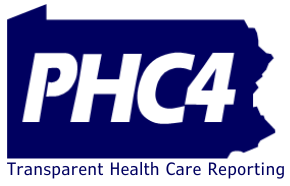Many researchers have used data from the Pennsylvania Health Care Cost Containment Council (PHC4) to conduct studies in the fields of public health, epidemiology, and health services research. This month we profile a project using PHC4 hospital discharge data performed at the Jefferson School of Population Health (JSPH). The data analyses have been managed by Albert Crawford, PhD, who has previously analyzed PHC4 data at JSPH. The Principal Investigator of the study is Robert Simmons, DrPH, Director of the Masters in Public Health program at JSPH.
The project assesses 1) the degree to which recent, post-legislation decreases in hospitalization rates for Acute Myocardial Infarction (AMI) are associated with, and possibly attributable to, workplace smoking ban legislation, and 2) whether such recent observed reductions in AMI hospitalization rates have been accompanied by similar reductions in hospitalization for other chronic conditions — Coronary Artery Disease, Cerebrovascular Disease, Congestive Heart Failure, Asthma, and Chronic Obstructive Pulmonary Disease — which are caused and/or exacerbated by smoking and second-hand smoke exposure.
This project represents an interesting informal collaboration among three levels of government — federal, state, and local — and a university. Funding originated at the federal Centers for Disease Control and Prevention, which in turn funded the Philadelphia Department of Public Health, which then contracted with JSPH to acquire and analyze the Commonwealth’s PHC4 data.
The research employs an innovative approach to assessing the impact on health, measured by hospitalization rates, of legislation at two levels of government – City and Commonwealth. On January 8, 2007, the City of Philadelphia instituted a comprehensive tobacco control ordinance, the Philadelphia Clean Indoor Air Worker Protection Law (CIAWPL), to reduce tobacco smoke exposure. Subsequently, on September 11th, 2008, the Commonwealth of Pennsylvania enacted a more limited but statewide smoking ban.
The research assesses potential impacts of both pieces of legislation, City and State, first in Philadelphia (PHC4 Region 9) and then in its four surrounding suburban counties (Region 8). This methodological approach is innovative and complex. However, there are substantial strengths of the PHC4 data which mitigate many problems. As Dr. Crawford notes, “PHC4 data are an exceptional resource for health services research. Their historical depth and state-wide scope are exceptional, and the quality control of data collection and capability for risk adjustment address key methodological issues. The Jefferson School of Population Health looks forward to continued and expanded use of PHC4 data in the future.”
As stated above, Dr. Crawford is not new to analysis of PHC4 data. His first project at Jefferson, in 2001, employed PHC4 data to examine effects on hospitalization costs and outcomes following consolidation of hospitals into systems and acquisition of two medical school hospitals by a for-profit chain. This work included more than 1.5 million discharges from 49 acute-care hospitals in PHC4 Regions 8 and 9 from 1997 to 1999. In this project, Dr. Crawford collaborated with David B. Nash, MD, JSPH Dean and long-time head of the PHC4 Technical Advisory Group.
Return to the Case Studies page: VIEW ALL CASE STUDIES


